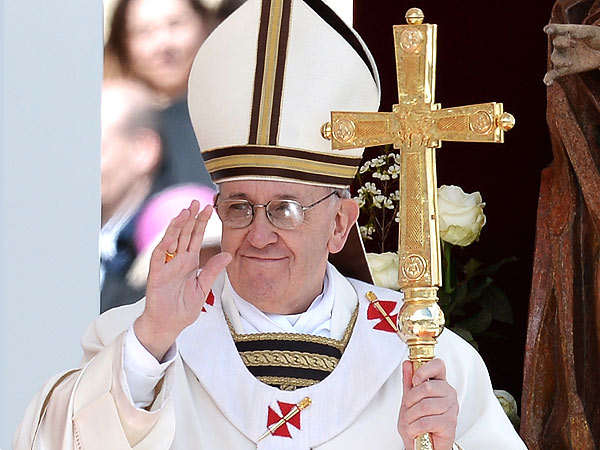SEOUL – Pope Francis beatified 124 early Korean martyrs Saturday at a mass in Seoul and challenged the massive crowd to ask what values they might be willing to die for in an increasingly materialistic, globalised world.
Hundreds of thousands of believers, most of them invited church groups from across South Korea. attended the open-air ceremony, held in hot, humid conditions in Gwanghwamun plaza — the city’s main ceremonial thoroughfare.
The centrepiece of the pope’s five day visit, the beatification mass was the subject of a massive security operation, with bridges, roads and subway stations closed, and police snipers posted on the roofs of overlooking office buildings, which had their windows sealed.
The most prominent among those to be beatified was an 18th century nobleman, Paul Yun Ji-Chung, who became Korea’s first Catholic martyr when he was executed in 1791 after clashing with Confucian officials.

Pope Francis led the open-air mass at Gwanghwamun Square in Seoul. (AFP)
According to the Church, around 10,000 Koreans were martyred in the first 100 years after Catholicism was introduced to the peninsula in 1784.
“They knew the cost of discipleship … and were willing to make great sacrifices,” Francis said in his sermon after the brief beatification ceremony, which gives the martyrs the title “blessed” and marks their first step towards sainthood.
On the last papal visit to South Korea 25 years ago, Pope John Paul II canonised 103 martyrs.
What would we die for?
“They challenge us to think about what, if anything, we ourselves would be willing to die for,” he said.

Hundreds of thousands of people attended the beatification mass. (AFP)
Continuing the theme that has dominated his visit, the pope said the lessons to be learned from the martyrs were as important as ever in an era marked more by selfishness and greed than sacrifice.
“Their example has much to say to us who live in societies where, alongside immense wealth, dire poverty is silently growing; where the cry of the poor is seldom heeded,” he said.
Up to one million people had been expected to converge on the venue for the mass, although only 200,000 who pre-registered were allowed to pass through dozens of metal detectors placed along a 4.5-kilometre (three mile) long security ring around the main plaza.
Some arrived hours before dawn, and whiled away the time reading the bible in small groups.
South Korea has a fast-growing Catholic community that punches well above its minority weight in one of Christianity’s most muscular Asian strongholds.

Catholic worshippers hold prayer beads (rosaries) as they attend the mass. (AFP)
As the sun rose, Gwanghwamun boulevard was already crammed with spectators for a one-kilometre stretch north of City Hall.
The papal stage, topped with a giant cross stood at the top of the boulevard, backed by the giant tiled roof of the Joseon dynasty Gyeongbokgung Palace.
In the 18th and 19th centuries, unrepentant Catholics were generally paraded from Gwanghwamun southwest to Seosomun Gate where they were publicly executed.
Pope Francis began the day at a martyrs’ shrine at Seosomun and then made the journey of the condemned in reverse to Gwanghwamun, riding in an open-topped vehicle and waving to the ecstatic crowds on either side.
Comforts ferry disaster relatives
Organisers had been concerned about the relatives of victims of April’s Sewol ferry disaster, who have been camped out in Gwanghwamun for weeks to push their campaign for a full independent inquiry into the tragedy, which claimed 300 lives — most of them schoolchildren.

Pope Francis (L) hugs South Korean Cardinal Andrew Yeom Soo-Jung as his cap is blown off by the wind. (AFP)
In the end, 600 family members were invited to attend the mass, effectively incorporating the protest into the event.
As he passed by, the pope stopped and stepped down from his vehicle to greet the relatives, including Kim Young-Oh, whose daughter died in the disaster and who has been on a hunger strike for more than one month.
“I am a Buddhist but I think the Pope can help us,” said Choi Keum-Bok, a construction worker who lost his son in the disaster.
Later Saturday, the pope was to travel to a hilltop community for the sick and disabled in Kkottongnae, around 80 kilometres south of Seoul.
The pope’s visit is very much aimed at fuelling a new era of growth for Catholicism in Asia, where the Church is making some spectacular gains in Asia, but where Catholics still only account for 3.2 percent of the continent’s population.


